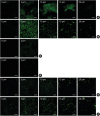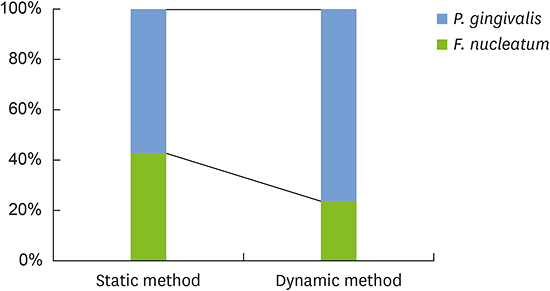1. Costerton JW, Stewart PS, Greenberg EP. Bacterial biofilms: a common cause of persistent infections. Science. 1999; 284:1318–1322.

2. Hall-Stoodley L, Costerton JW, Stoodley P. Bacterial biofilms: from the natural environment to infectious diseases. Nat Rev Microbiol. 2004; 2:95–108.

3. Filoche S, Wong L, Sissons CH. Oral biofilms: emerging concepts in microbial ecology. J Dent Res. 2010; 89:8–18.

4. Kolenbrander PE, Andersen RN, Blehert DS, Egland PG, Foster JS, Palmer RJ Jr. Communication among oral bacteria. Microbiol Mol Biol Rev. 2002; 66:486–505.

5. Ximénez-Fyvie LA, Haffajee AD, Socransky SS. Comparison of the microbiota of supra- and subgingival plaque in health and periodontitis. J Clin Periodontol. 2000; 27:648–657.

6. Paster BJ, Boches SK, Galvin JL, Ericson RE, Lau CN, Levanos VA, et al. Bacterial diversity in human subgingival plaque. J Bacteriol. 2001; 183:3770–3783.

7. Blanc V, Isabal S, Sánchez MC, Llama-Palacios A, Herrera D, Sanz M, et al. Characterization and application of a flow system for
in vitro multispecies oral biofilm formation. J Periodontal Res. 2014; 49:323–332.

8. Park JH, Lee JK, Um HS, Chang BS, Lee SY. A periodontitis-associated multispecies model of an oral biofilm. J Periodontal Implant Sci. 2014; 44:79–84.

9. Walker C, Sedlacek MJ. An in vitro biofilm model of subgingival plaque. Oral Microbiol Immunol. 2007; 22:152–161.
10. Guggenheim B, Giertsen E, Schüpbach P, Shapiro S. Validation of an
in vitro biofilm model of supragingival plaque. J Dent Res. 2001; 80:363–370.

11. Thomas WE, Trintchina E, Forero M, Vogel V, Sokurenko EV. Bacterial adhesion to target cells enhanced by shear force. Cell. 2002; 109:913–923.

12. Ding AM, Palmer RJ Jr, Cisar JO, Kolenbrander PE. Shear-enhanced oral microbial adhesion. Appl Environ Microbiol. 2010; 76:1294–1297.

13. Goeres DM, Loetterle LR, Hamilton MA, Murga R, Kirby DW, Donlan RM. Statistical assessment of a laboratory method for growing biofilms. Microbiology. 2005; 151:757–762.

14. Rudney JD, Chen R, Lenton P, Li J, Li Y, Jones RS, et al. A reproducible oral microcosm biofilm model for testing dental materials. J Appl Microbiol. 2012; 113:1540–1553.

15. Saunders KA, Greenman J. The formation of mixed culture biofilms of oral species along a gradient of shear stress. J Appl Microbiol. 2000; 89:564–572.

16. Haffajee AD, Socransky SS. Microbial etiological agents of destructive periodontal diseases. Periodontol 2000. 1994; 5:78–111.

17. Okuda T, Kokubu E, Kawana T, Saito A, Okuda K, Ishihara K. Synergy in biofilm formation between
Fusobacterium nucleatum and
Prevotella species. Anaerobe. 2012; 18:110–116.

18. Fonseca AP, Sousa JC. Effect of shear stress on growth, adhesion and biofilm formation of
Pseudomonas aeruginosa with antibiotic-induced morphological changes. Int J Antimicrob Agents. 2007; 30:236–241.

19. Cotter JJ, O'Gara JP, Stewart PS, Pitts B, Casey E. Characterization of a modified rotating disk reactor for the cultivation of
Staphylococcus epidermidis biofilm. J Appl Microbiol. 2010; 109:2105–2117.

20. Saito Y, Fujii R, Nakagawa KI, Kuramitsu HK, Okuda K, Ishihara K. Stimulation of
Fusobacterium nucleatum biofilm formation by
Porphyromonas gingivalis
. Oral Microbiol Immunol. 2008; 23:1–6.

21. Abiko Y, Sato T, Mayanagi G, Takahashi N. Profiling of subgingival plaque biofilm microflora from periodontally healthy subjects and from subjects with periodontitis using quantitative real-time PCR. J Periodontal Res. 2010; 45:389–395.

22. Loozen G, Ozcelik O, Boon N, De Mol A, Schoen C, Quirynen M, et al. Inter-bacterial correlations in subgingival biofilms: a large-scale survey. J Clin Periodontol. 2014; 41:1–10.

23. Shaddox LM, Alfant B, Tobler J, Walker C. Perpetuation of subgingival biofilms in an in vitro model. Mol Oral Microbiol. 2010; 25:81–87.
24. Fraud S, Maillard JY, Kaminski MA, Hanlon GW. Activity of amine oxide against biofilms of Streptococcus mutans: a potential biocide for oral care formulations. J Antimicrob Chemother. 2005; 56:672–677.
25. Hope CK, Petrie A, Wilson M.
In vitro assessment of the plaque-removing ability of hydrodynamic shear forces produced beyond the bristles by 2 electric toothbrushes. J Periodontol. 2003; 74:1017–1022.

26. Thurnheer T, Gmür R, Guggenheim B. Multiplex FISH analysis of a six-species bacterial biofilm. J Microbiol Methods. 2004; 56:37–47.
27. Pratten J, Wills K, Barnett P, Wilson M.
In vitro studies of the effect of antiseptic-containing mouthwashes on the formation and viability of
Streptococcus sanguis biofilms. J Appl Microbiol. 1998; 84:1149–1155.

28. Dû LD, Kolenbrander PE. Identification of saliva-regulated genes of
Streptococcus gordonii DL1 by differential display using random arbitrarily primed PCR. Infect Immun. 2000; 68:4834–4837.

29. Ahn SJ, Kho HS, Lee SW, Nahm DS. Roles of salivary proteins in the adherence of oral streptococci to various orthodontic brackets. J Dent Res. 2002; 81:411–415.
30. Morris EJ, McBride BC. Adherence of Streptococcus sanguis to saliva-coated hydroxyapatite: evidence for two binding sites. Infect Immun. 1984; 43:656–663.
31. Lamont RJ, El-Sabaeny A, Park Y, Cook GS, Costerton JW, Demuth DR. Role of the
Streptococcus gordonii SspB protein in the development of
Porphyromonas gingivalis biofilms on streptococcal substrates. Microbiology. 2002; 148:1627–1636.

32. Maeda K, Nagata H, Yamamoto Y, Tanaka M, Tanaka J, Minamino N, et al. Glyceraldehyde-3-phosphate dehydrogenase of
Streptococcus oralis functions as a coadhesin for
Porphyromonas gingivalis major fimbriae. Infect Immun. 2004; 72:1341–1348.

33. Kaplan CW, Lux R, Haake SK, Shi W. The
Fusobacterium nucleatum outer membrane protein RadD is an arginine-inhibitable adhesin required for inter-species adherence and the structured architecture of multispecies biofilm. Mol Microbiol. 2009; 71:35–47.











 PDF
PDF ePub
ePub Citation
Citation Print
Print





 XML Download
XML Download